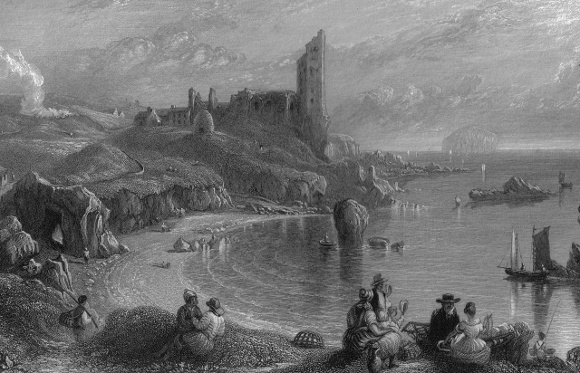John Keats, selected poems Contents
To Ailsa Rock: Imagery, symbolism and themes
Imagery and symbolism of To Ailsa Rock
Size and mystery
The rock symbolises the mighty power of nature, as well as conveying its age and sense of mystery. The rock also symbolises the feelings of awe experienced when human beings are faced with a natural phenomenon at once huge and unknowable.
The image of a pyramid is used in the opening line, suggesting age, majesty and mystery as well as the rock’s size. The two environments in which the rock has existed – the sea and the air – are themselves associated with the grandest creatures inhabiting each: whales and eagles.
Concealment
The sense of foreboding is conveyed by the references to the rock’s hiddenness: its shoulders are ‘mantled’ (covered in a cloak), its forehead ‘hid’, it is covered by clouds, with only the ‘scream’ of a voice to indicate its personality. Although apparently asleep now, it may still remember the content of its deep ‘fathom dreams’ but they are not outwardly expressed.
Investigating imagery and symbolism in To Ailsa Rock...
- What aspects of nature does the rock symbolise?
- What impression is given of the rock’s ‘personality’?
- Why do you think Keats specifically associates the sea with whales and the air with eagles?
 Themes in To Ailsa Rock
Themes in To Ailsa Rock
The poem expresses the awe Keats felt when confronted with the vast size of the rock and its ‘mighty power’. The rock represents nature at its most awe-inspiring and unknowable. Man may have questions to ask, but Nature keeps her secrets to herself.
Another theme is that of man’s relative insignificance and lack of power. Only an earthquake was able originally to ‘heave’ the rock to the earth’s surface and, so permanent does Ailsa Rock now seem to Keats, that not even another earthquake would shift it.
There is a strong sense of the mystery of creation about the poem as the questions Keats wants to ask about the rock’s age and its dual existence – first buried beneath the waves and now above them – find no answers.
Investigating themes in To Ailsa Rock...
- How does the poem express the theme of nature’s infinite and unknowable power?
- To what extent is the relative insignificance of humanity a theme too?
- In what ways does the silence with which the speaker’s questions are met relate to the poem’s themes?
Recently Viewed
Related material
Scan and go
Scan on your mobile for direct link.